Yaesu FT-1000MP review
 Yaesu flagship, Yaesu flagship. Yaesu flagship, Yaesu flagship, Yaesu flagship, IC-775DSP či IC-781, but none of them achieved the success of thousands. Version D, MP, Mark V to the current Field, both mains and mains powered….
Yaesu flagship, Yaesu flagship. Yaesu flagship, Yaesu flagship, Yaesu flagship, IC-775DSP či IC-781, but none of them achieved the success of thousands. Version D, MP, Mark V to the current Field, both mains and mains powered….
The difference between the original FT-1000 and FT-1000D is significant, The FT-1000MP is not just another upgrade, but largely new tranceiver. It is produced in DC and AC/DC versions (power supply 115/230V DC or 13.8V AC). The FT-1000MP Mark V is basically a thousand with increased power, amplifier in class A and improved filtering. “She improved” but also the price. That's why I chose the FT-1000MP for the review and not the Mark-V.
But what is behind the success of this tranceiver? What makes it special?

The FT-1000MP will impress everyone with its design and layout of controls. The front panel is designed very purposefully and clearly. The large multi-color display also improves the impression. Therefore, it seems incredible, that the control elements are up to 95. The FT-1000MP is indeed “manual” tranceivrom nevertheless, that it also uses currency like other modern tranceivres. After pressing a pair of buttons (FAST + ENT) a number of functions can be set with the rattling buttons, levels are set with the main tuning knob. Some, such as advanced digital sound processing of the broadcast signal is adjusted according to the microphone used and the operator's requirements. The entire setting is described in the manual, however, if the operator gets confused in the setup, can easily start from the initial factory settings.
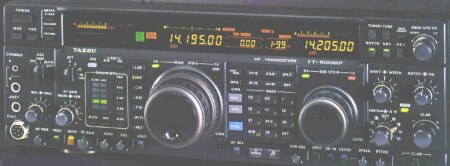
| 00 | |
| GENERALLY | 0 |
| 0 | |
| RX frequency range: | 100 kHz ~ 30 MHz |
| TX frequency range: | 160 ~ 10m amateur bands only – extension on request; |
| Frequency stability: | <±10 ppm (-10°C ~ 50°C) |
| 0 | <±2.0 ppm (0°C ~ 50°C) w/o TCXO-4 |
| 0 | <±0.5 ppm (0°C ~ 50°C) w/o TCXO-6 |
| Frequency accuracy: | <±7 ppm (except for FM <±500 Hz) |
| w/TCXO-4: | <±2 ppm (FM <±460 Hz) |
| w/TCXO-6: | <±0.5 ppm (FM <±460 Hz) |
| more than 1W to: | -10°C ~ 50°C |
| Fashion: | LSB, USB, CW, OFF, FSK, AM, FM |
| Frequency step: | 0.625/11.25/2.5/5/10 Hz and SSB, |
| 0 | CW, RTTY & Packet; 100 Hz na AM a FM |
| Antenna impedance: | 50 Ohms asymmetric |
| amtérsky KV/VKV transceiver: | 90 ~ 129, 180 ~ 258 VAC, 50/60 Hz a 13.5 VDC |
| 0 | DC – js model also sold (FT-1000MP/DC) |
| Consumption (approx): | 2.4A RX (no signal) 2.8A RX (with a signal) |
| 0 | 19A TX (100 W) |
| Dimensions (WxHxD): | 410 x 135 x 347 mm |
| Weight (approx): | 15 kg |
| 0 | |
| TRANSMITTER | 0 |
| Output power: | adjustable po 100 W (25 W AM carrier) |
| Load cycle: | 100% @ 50 W, 50% @ 100 W (FM &town.; RTTY, 3-TX minutes) |
| you only need to set the optimal level of the transmitted modulation using the RP1 trimmer and mode: | SSB: J3E balanced modulator with filtering |
| 0 | AM: A3E injection at low level (in the first stages) |
| 0 | FM: F3E reactance modulator |
| 0 | OFF: J1D, J2D OFF |
| Maximum lift on FM: | ±2.5 kHz |
| FSK shift frequency: | 170, 425 a 850 Hz |
| Packet shift frequency: | 200, 1000 Hz |
| Suppression of harmonics: | at least 50dB below PEP power |
| Carrier suppression for SSB: | at least 40dB below PEP power |
| Suppression of unwanted band on SSB: | at least 50dB below PEP power |
| The width of the transmitted audio band (SSB): | not more than -6dB from 400 do 2800 Hz |
| IMD 3rd order: | -31dB @ 100 W PEP, or better |
| Microphone impedance: | 500 to 600 ohms |
| 0 | |
| RECEIVER | 0 | |
| Receiver type: | quadruple superhet (triple for FM) | |
| Intermediate frequencies: | Main RX | Secondary RX |
| 0 | 70.455 MHz | 47.21 MHz |
| 0 | 8.215 MHz | 455 kHz |
| 0 | 455 kHz | 00 |
| 0 | 10.25 kHz (EDSP) | 0 |
| Sensitivity (pre 10 dB S/N): | ||||
| IPO | switched on | off | off | off |
| Frequency | 150 ~ 250 kHz | 250 ~ 500 kHz | 0.5 ~ 1.8 MHz | 1.8 ~ 30 MHz |
| 0 | ||||
| Mode | ||||
| SSB, CW (2.4 kHz) | 5 uV | 4 uV | 2 uV | 0.25 uV |
| AM (6 kHz) | 40 uV | 32 uV | 16 uV | 2 uV |
| 29 You can hear what the NA1ISS signal looks like (12 dB SINAD) | – | – | – | 0.5 uV |
| Selectivity (-6 / -60 dB): | |||
| Chosen | Modes | Min -6dB BW | Max -60 dB BW |
| 2.4 kHz | all except FM | 2.2 kHz | 4.2 kHz |
| 2.0 kHz | all but AM, FM | 2.0 kHz | 3.6 kHz |
| 500 Hz | CW, RTTY, Packet | 500 Hz | 1.8 kHz |
| 250 Hz | CW, RTTY | 250 Hz | 700 Hz |
| – | AM (wide) | 4 kHz | 14 kHz |
| 0 | FM | 8 kHz | 19 kHz |
| Dynamic range: | 108 dB (@ 50 kHz, 500 Hz BW, RF predzos.vyp.) |
| Squelch sensitivity: | 1.8 ~ 30 MHz: (CW, SSB, AM): <2.0uV |
| 28 ~ 30 MHz: (FM): | <0.32uV |
| Intermediate frequency suppression (1.8 ~ 30 MHz): | 80 dB and more (Hl. RX) |
| 0 | 60 dB and more (Dr. RX) |
| Mirror frequency suppression: (1.8 ~ 30 MHz): | 80 dB and more (Hl.RX) |
| 0 | 50 dB and more (Dr.RX) |
| Rozsah IF shift: | ±1.12 kHz |
| Max. LF power: | 1.5In on 4 ohmic load < 10% THD |
| NF load impedance: | 4 to 8 ohms |
The constructors really had everyone in mind, from contestants, through normal operation to radio broadcasting. Tuning deserves special attention. The FT-1000MP has two receivers with separate tuning knobs. The tuning step is adjustable in six levels from 0,625 Hz po 20 Hz (Determination of the plant). There are a thousand steps for one turn of the knob. Press the FAST button to increase the tuning speed by 2x or 4x. Pressing UP/DOWN tunes after 100 kHz, respectively 1 MHz with activated FAST. The rapping switch can be programmed to tune in steps from 1 po 100 kHz.

Switching between bands is done with the buttons on the numeric keypad. For example, by pressing a button 14 switches TCVR to 14 ,250 MHz SSB s filtrom 2,4 kHz. Pressing the same button again will retune the TCVR to 14,020 MHz CW s filtrom 250 Hz. This preset can be set by the operator according to his own imagination. The desired frequency for the main and secondary RX can also be entered from the numeric keypad. Each of them has two VFOs and a clariefier (RIDE) adjustable in the maximum range +/-9,99 kHz, however, the size of the detuning can be reduced via the menu.
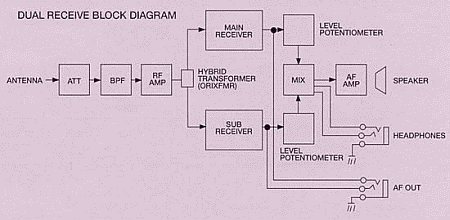
The sub VFO works similarly to the main VFO. It is convenient for monitoring another frequency. It is also used on SPLIT. It is also possible to transfer the setting from the main VFO (frequency, mode, filtering) na sub VFO. Second RX, tuned by this VFO works as a superhet with two intermediate frequencies, main RX with three. The output audio signals can be mixed, or listen separately when using stereo headphones – with the left earpiece the main RX and the right second RX!
The transceiver has 99 memory, which can be divided into five groups. The frequency is stored in the memory, mode and filtering. Working with memories is convenient, moving, copying, memory tuning and much more… In addition, there is more 5 memories marked as Quick Memory Bank, which are suitable for temporary recording, without overwriting common memories. Memory scan, Programmed Memory Scanning still uses 9 special memories for this purpose.
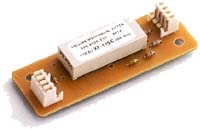
EDSP is applied on the third intermediate frequency on the frequency 10,24 kHz. It uses 16 bit NEC processor working with clock 33 MHz. Setting the EDSP bandwidth is possible in several variants. Autonotch is very effective, which is very fast thanks to it, that the EDSP circuits constantly analyze the components of the audio output and in the event of the discovery of a disturbing signal, they immediately erase it. SHIFT and WIDTH also work reliably. Noise reduction, noise suppression, works satisfactorily, although not excellent. However, the two noise blankers work well. Overall it is possible to say, that the FT-1000MP is very well equipped to suppress QRM.
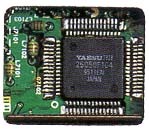

CW operation is very simple. Just connect a mechanical key or trap. The built-in electronic key offers two iambic modes, variable weighting, ACS (automatic maintenance of spaces between characters), semi aj full break-in (CSK). All parameters and timings are adjustable in the menu. After connecting the FH-1 external controller, it is also possible to use 6 remembers the broadcast of the challenge and the like.
Narrowband FM operation on 28 MHz is also possible with the FT-1000MP. A low-level one is used to work through converters 88,5 Hz tone and standard 100 kHz bounce. This parameter can also be changed in the menu.

An automatic ATU is a standard part of the FT-1000MP. It can adapt an antenna with impedance from 20 po 150 ohm. MORE 39 memory, which enables quick tuning of a commonly used antenna.
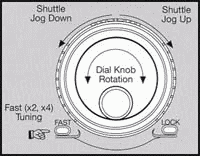 A synchro detector can be activated to receive AM radio stations. It will be used for signals from long distances, which are subject to various phase distortions. In this case, RX is switched to LSB and the carrier frequency is added. Alternatively, it is possible to achieve high-quality reception when listening to headphones by precisely tuning the main RX to LSB and the sub RX to USB.
A synchro detector can be activated to receive AM radio stations. It will be used for signals from long distances, which are subject to various phase distortions. In this case, RX is switched to LSB and the carrier frequency is added. Alternatively, it is possible to achieve high-quality reception when listening to headphones by precisely tuning the main RX to LSB and the sub RX to USB.
The internal design of the tranceivra is very clean. After removing the top cover, there is not much to see. There is a speaker on the front right, behind it the input circuits. The left side is filled by the final stage cooler. When viewed from below, the intermediate frequency filters are certainly the most interesting. Connections between circuit boards are realized by cable bundles terminated by connectors and flat cables. It is also a positive, that several circuits are in wall boxes.

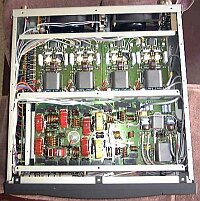
Other accessories include, of course, microphones. Yaesu makes two suitable types of desk microphones, MD-100 a MD-200. The SP-8 speaker cabinet is also recommended. FTV-1000 is a 6m transverter. The selection of filters is also rich and produced by various manufacturers. Yaesu offers the following: 8,215 MHz filtre YF-114SN 2,0 kHz SSB filter, YF-114CN 250 Hz CW filter, a-N-A 455 kHz: YF-110SN 2,0 kHz SSB filter, YF-110CN 250 Hz CW filter, YF-115C 500 Hz Collins mechanical CW filter (for the second RX). TCXO-4 or TCXO-6 can be purchased to increase stability. DVS-2 will be an interesting addition, which is a digital memory for calling a prompt, for example.
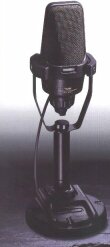
The transceiver comes with a handheld microphone and a 104-page manual. A transceiver of this caliber and complexity needs a good and clear manual, and this one definitely did not disappoint me.
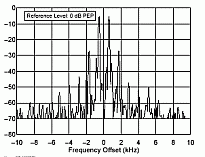 |
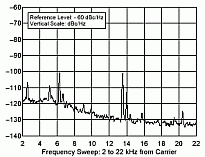 |
A few months of operation and comparison with the IC-751 will tell, how development has progressed in sixteen years. The IC-751 is not a weak transceiver, but the FT-1000MP simply cannot match. The reception is very clean and the autonotch is really great. The quality of broadcast audio even with a handheld microphone is excellent. Setting up your speech processor requires patience, but it's nothing complicated. The MONITOR function detects the signal on 455 kHz, not from the final stage. This is how it can happen, that we wake up the final stage of the tranceiver, even if you can't tell from the audio. I can say, that Sako Hagesawa JA1MP would be proud of his technicians and would certainly be happy.



